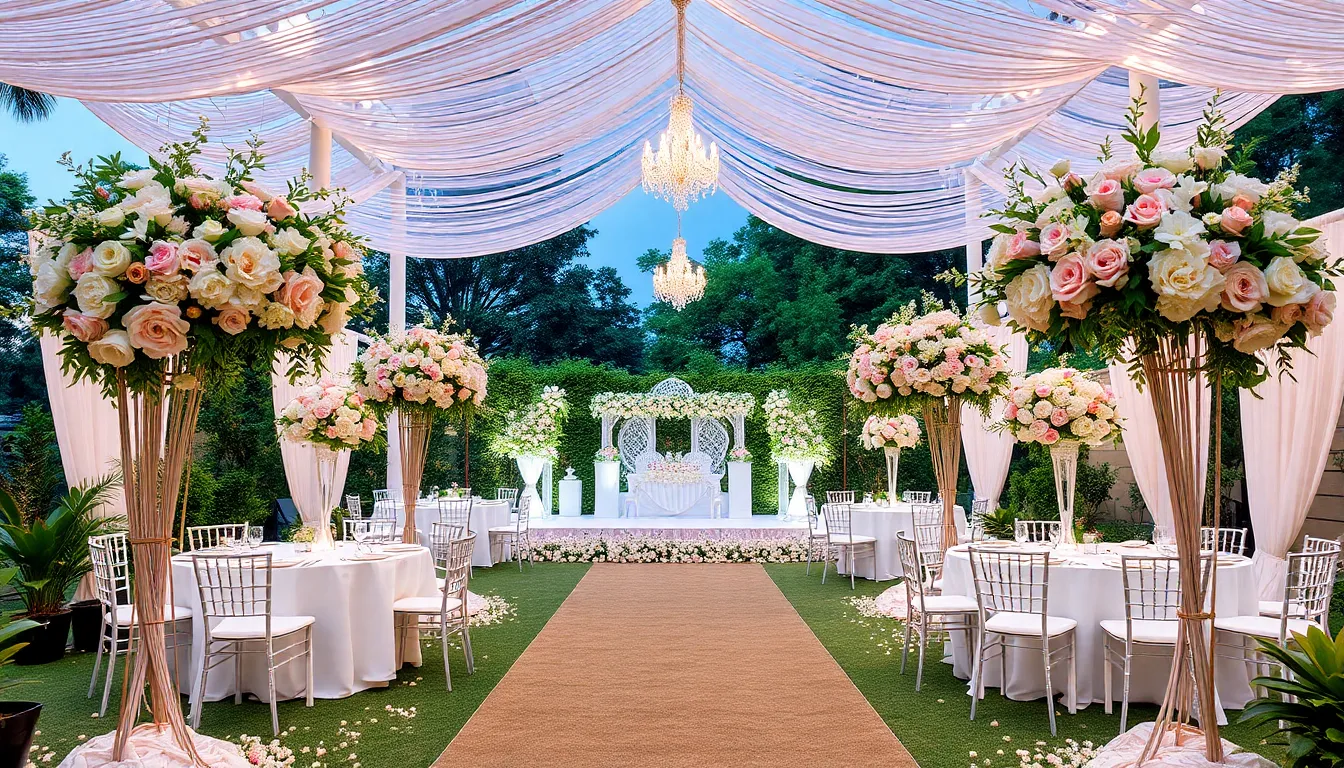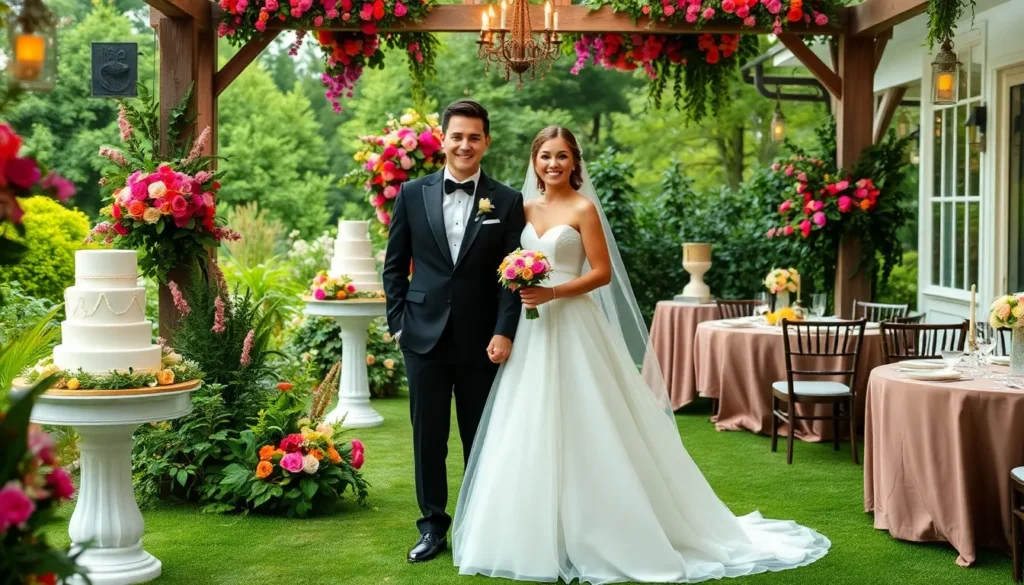Planning a wedding can feel like navigating a minefield of expenses. From the moment the ring goes on, couples quickly realize that love isn’t the only thing that comes with a price tag. Whether it’s the cake that costs more than a small car or the floral arrangements that seem to bloom with dollar signs, the list of wedding expenses can get overwhelming fast.
List of Wedding Expenses
Budgeting for a wedding involves multiple components that add up quickly. Common wedding expenses include venue rentals, catering services, and photography packages. Couples often overlook costs like officiants and wedding insurance, but these can also impact the overall budget. The average U.S. wedding costs around $34,000, according to The Knot’s 2021 survey.
Couples should allocate funds for wedding attire, including the bridal gown and tuxedo rentals. Floral arrangements and decorations play a significant role in creating the ceremony’s ambiance, often leading to hefty expenses. Wedding cakes, while an essential highlight, also contribute to the financial burden.
Additionally, entertainment expenses for DJs or live bands can vary based on location and the scale of the event. Consideration of transportation options must occur early in the planning process. Couples might need to account for accommodation costs for out-of-town guests, which can accumulate.
Spending on wedding stationery, including invitations and thank-you cards, requires attention too. It’s essential to anticipate costs for hair and makeup services for the bridal party when creating the budget. Photobooths, favors, and other personal touches can enhance the celebration but may lead to unexpected expenses.
Understanding the range of costs associated with these categories helps couples prioritize their spending. This knowledge enables them to allocate resources effectively, ensuring they can achieve their vision without compromising financial stability.
Major Categories of Wedding Expenses

Understanding major wedding expense categories helps couples plan effectively. The following sections detail the primary costs associated with weddings.
Venue Costs
Venue costs typically represent a significant portion of a wedding budget. Couples often pay $9,000 on average for venue rentals, depending on location and amenities. Factors like guest capacity and style influence prices. Popular venues may include gardens, banquet halls, or beachfront areas. For example, those planning destination weddings can explore beautiful wedding venues in Mallorca to find unique and scenic options. Additional fees can arise from setup, cleaning, and extra hours. Couples must consider these variables while selecting venues to ensure they fit within their overarching budget.
Catering Expenses
Catering expenses play a crucial role in wedding planning. Couples usually allocate around $4,500 for catering services, which includes food, beverages, and service staff. Various options exist, such as plated meals, buffets, or food stations. Each choice affects guest experience and budget constraints. Couples often forget to include gratuity, which can add an additional 15-20% to the total. Adjusting catering choices allows couples to balance quality and cost while satisfying their guests.
Attire and Accessories
Attire and accessories significantly impact wedding budgets. The average spending for wedding attire, including dresses, suits, and accessories, can reach $2,500. Bridal gowns usually account for a substantial portion of this figure, averaging between $1,000 to $3,000. Groom attire also requires attention, as rental or purchase costs can add up. Couples should consider shoes, jewelry, and hair accessories alongside their main outfits. Staying within the attire budget ensures a polished look without unnecessary financial strain.
Other Wedding Expenses to Consider
A wedding budget encompasses various overlooked expenses. Couples should consider all aspects for a well-rounded financial plan.
Decorations and Florals
Decorations and floral arrangements often represent a significant part of wedding budgets. Couples frequently allocate around $2,000 to $3,000 for these items. Centerpieces, altar displays, and venue decorations contribute to the overall aesthetic. Seasonal flowers can reduce costs, while DIY options might also provide savings. Planning the design theme early ensures better coordination between floral selections and decor choices.
Photography and Videography
Photography and videography capture the wedding’s most precious moments. On average, couples invest about $3,000 for photography services and an additional $1,500 for videography. Booking professionals with good portfolios can make a notable difference. Couples should prioritize discussing expectations, styles, and packages upfront. Reviewing contracts carefully prevents unexpected fees and ensures quality coverage of the event.
Entertainment and Music
Entertainment and music set the tone for the celebration. Couples commonly budget between $1,000 and $2,500 for DJs or live bands. The selection often plays a pivotal role in the guests’ experience. Considering the length of the performance also affects pricing. Engaging a reputable entertainer increases the chances of a lively atmosphere, ensuring everyone enjoys the festivities.
Budgeting for Your Wedding
Budgeting for a wedding requires careful planning and prioritizing expenses. Couples benefit from understanding their overall financial situation and setting realistic limits.
Setting a Realistic Budget
A realistic budget reflects personal financial circumstances and wedding expectations. He or she should list major expenses, including the venue, catering, and attire, to gauge total costs. Each category contributes to the overall expenditure. For guidance, The Knot’s 2021 survey indicates the average wedding costs around $34,000. Couples can also account for additional costs like officiants and insurance, typically overlooked, to ensure a comprehensive budget. By creating a detailed budget, each couple can allocate funds effectively, aligning their desires with financial capabilities.
Tips for Saving on Wedding Expenses
Saving on wedding expenses starts with careful planning and research. Couples can consider off-peak wedding dates to secure discounts on venues and services. Engaging local vendors often yields more affordable solutions, from catering to photography. DIY projects can also reduce costs for decorations and floral arrangements, making the event personal. Prioritizing must-haves over nice-to-haves assists in maintaining budget control. Using digital invitations instead of printed ones can minimize stationery expenses, and negotiating with vendors may lead to better rates. Each of these strategies contributes to managing a wedding budget successfully while achieving a memorable celebration.
Conclusion
Navigating the financial landscape of wedding planning can be daunting. By understanding the various expenses involved couples can make informed decisions that align with their vision and budget. Prioritizing essential costs while being mindful of overlooked expenses ensures a smoother planning process.
With careful budgeting and strategic choices couples can create a memorable celebration without straining their finances. Embracing creativity through DIY projects and negotiating with vendors can further enhance their experience. Ultimately the goal is to celebrate love while maintaining financial stability.

